A J Poyiadgi is a creator with a deservedly growing profile on the U.K. small press scene. Coming to prominence when his comic Teapot Therapy was shortlisted for the Observer/Jonathan Cape/Comica short story prize, Poyiadgi has gone on to contribute to respected anthology titles like David O’Connell’s ink + PAPER and Mike Medaglia’s Wu Wei. His comics are beautiful, lyrical and contemplative affairs, with the reading experience often enhanced by their deliberately designed physicality. From minicomics in teabags to fold-out comics, through to origami comics, Poyiadgi’s work embraces both the tactile and the meditative. As part of our ongoing series of ‘Small Press Spotlight on…’ interviews at Broken Frontier I chatted with A J Poyiadgi about his small press projects to date, the design decisions behind his distinctive approach to sequential art, and just why a good old cup of tea plays such an important role in his work…
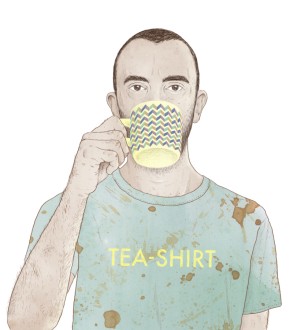 BROKEN FRONTIER: You’re on the record as describing your work as making “films by day and comics by night.” Could you give us a little background on your artistic journey so far and your entry point into creating comics?
BROKEN FRONTIER: You’re on the record as describing your work as making “films by day and comics by night.” Could you give us a little background on your artistic journey so far and your entry point into creating comics?
A J POYIADGI: I’ve always wanted to make comics. At college the closest I came was a storyboarding project. This led to an interest in animation, which at the time felt like an exciting medium to explore, so I specialised in it after a year of training in design and illustration. By the time I graduated my portfolio consisted of short animations and films so I didn’t feel qualified to pursue comics as a career. I ended up working for the BBC as a trainee director and after a few years went freelance to direct ads and the occasional music video. But I always wanted to draw comics and so I eventually committed to entering the Graphic Short Story Prize, which was the first bit of comics work I dared to show anyone.
BF: Again quoting from your website bio you talk about the different natures of the creative process for both of your artistic disciplines noting you like “the collaborative nature of one and the solitary demands of the other.” Are there ways, though, in which you feel the two strands of your artistic endeavours inform or influence each other?
POYIADGI: My interest has always been to tell stories so practising in one medium has probably been a positive influence on the other. Learning about story structure, characters, framing, pacing; all these elements I’ve tried to get to grips with in film have probably informed my comics in some way. In turn I think having to construct every element of a panel without a handy cast and crew has been a lesson in performance, lighting and editing that feeds back into the filmmaking.
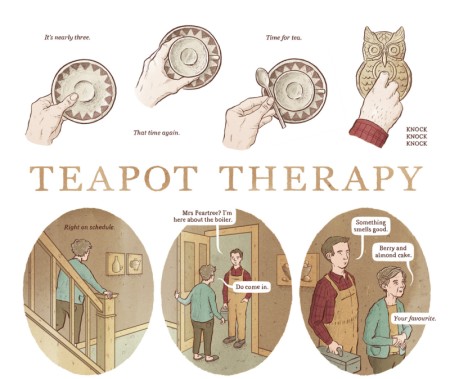 BF: Your first comic strip short Teapot Therapy was shortlisted for the Jonathan Cape/Observer short story competition (excerpt above and whole comic available to read online here). It’s a beautiful tale – a stunning visual interpretation of the ritual of the tea-making ceremony combined with a touching character study. What was your inspiration for such a subtle but deeply moving narrative?
BF: Your first comic strip short Teapot Therapy was shortlisted for the Jonathan Cape/Observer short story competition (excerpt above and whole comic available to read online here). It’s a beautiful tale – a stunning visual interpretation of the ritual of the tea-making ceremony combined with a touching character study. What was your inspiration for such a subtle but deeply moving narrative?
POYIADGI: Well it should come as no surprise that I’m a big fan of the humble brew. I love the shared ritual of having a cuppa; it’s a time for confiding and confessing and listening. I wondered what it would be like for someone to lose the person with which they share this daily ritual and how they might continue to use the ritual as a way of coping with the loss. It was then a question of the character finding a way to achieve this, even if it meant bringing strangers into the house under false pretences. Such is the need of the character to keep the memory of her loved one alive. It’s loneliness basically.
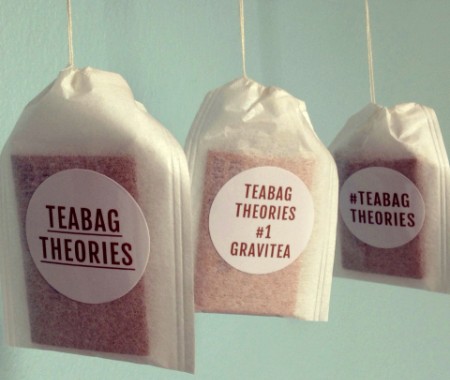
Teabag Theories – Minicomics in a teabag mixing the mysteries of science with everyone’s favourite brew!
BF: I can’t move on from Teapot Therapy without asking about your use of the brew to colour portions of the comic. What prompted this rather innovative use of beverage as an illustrative tool?
POYIADGI: With the tea theme in place it felt appropriate to use shades of brown as part of the colour palette. I thought it might also lend it a sepia quality but I’m not sure this comes through in the finished piece. At the planning stage I messed around with various brown ink and watercolour washes but then decided it would be nicer to use the real thing, especially since there’s always a cup of it on my desk. I made brews of varying strength and used a brush to create sheets of washes until I managed to get a consistency that looked half decent. I then scanned these in and used photoshop to change certain sections, such as items of clothing, into different colours. But the shade of brown that dominates the artwork is the original wash of tea.
BF: You’ve contributed to both David O’Connell’s critically-acclaimed anthology ink + PAPER with your haunting short ‘On Reflection’ (reviewed here at Broken Frontier and available to read online here) and to John Miers’s Score and Script exhibition with the magical ‘The Barkling’ (excerpt below and available to read online here). Can you tell us a little about both projects and how you became involved in them?
POYIADGI: David and John are both super talented so it’s been a pleasure to work on their projects. I got in touch with David soon after Teapot Therapy as I was excited about ink+PAPER #1, which was just about to launch. He was kind enough to ask me to contribute to #2 and so I developed this short idea about a man who faces his own reflection in the wake of an accident. I was unsure about the sections of ‘reflected’ dialogue but David was a great help in giving me the confidence to pursue it.
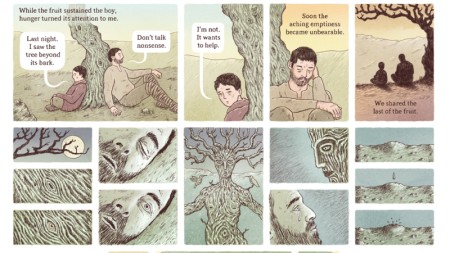 For the Score and Script project, I had met John a few times and was chuffed to be asked as the other contributors I had read and admired for years. It was a real challenge to interpret and distil John’s script into a one page story – I found it a revealing process and very telling of my interests and concerns when comparing my page to the others. I think John is planning to release a collection of all the pages later this year so it will be fascinating to read them back to back.
For the Score and Script project, I had met John a few times and was chuffed to be asked as the other contributors I had read and admired for years. It was a real challenge to interpret and distil John’s script into a one page story – I found it a revealing process and very telling of my interests and concerns when comparing my page to the others. I think John is planning to release a collection of all the pages later this year so it will be fascinating to read them back to back.
BF: One aspect of your work that is very distinctive is that tactile element to it. From the fold-out poster format of the print version of Teapot Therapy to your origami contribution to Mike Medaglia’s anthology Wu Wei, through to your new Teabag Theories – minicomics presented in a teabag! How much do you enjoy playing with that idea of the potential physicality of the comic-reading experience?
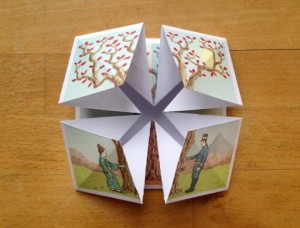 POYIADGI: I love the potential of comics as readable objects that you keep and cherish. Initially I chose the fold-out format because my stories were only a few pages long, but for Teabag Theories and Wu Wei it was my intention to try and create something tactile that you’d want to pick up and explore. For the origami comic (right) I liked the idea of creating a kind of story that unfolded as the paper was folded. I looked at different kinds of origami and settled on a design that wasn’t too complicated but that allowed for multiple ‘panels’ which could be read in any order depending on the way the paper was folded. It was a tough task but Mike Medaglia (the editor of the book) was great at listening to me ramble on about folding instructions and paper thicknesses so we got there in the end.
POYIADGI: I love the potential of comics as readable objects that you keep and cherish. Initially I chose the fold-out format because my stories were only a few pages long, but for Teabag Theories and Wu Wei it was my intention to try and create something tactile that you’d want to pick up and explore. For the origami comic (right) I liked the idea of creating a kind of story that unfolded as the paper was folded. I looked at different kinds of origami and settled on a design that wasn’t too complicated but that allowed for multiple ‘panels’ which could be read in any order depending on the way the paper was folded. It was a tough task but Mike Medaglia (the editor of the book) was great at listening to me ramble on about folding instructions and paper thicknesses so we got there in the end.
BF: Your recent strip for Shots magazine looks at the world of film-making and advertising through the lens of sequential art (you can read some of those strips here). Given your background was that something of a dream creative assignment for you?
POYIADGI: It’s a brilliant opportunity to work on a regular strip. But the prospect was daunting initially, knowing the magazine is read by a chunk of the advertising world. I found the best way to approach it was to focus on small, personal observations rather than big ideas. I think the result is more honest and hopefully more amusing. One of the biggest challenges is trying to make a gag work in a limited space. I seem to take forever to figure out the structure and pace and will usually swap panels and re-write lines at the last minute. Thankfully the editor gives me a lot of freedom so it usually pans out ok. And if all else fails, just add a talking cat.
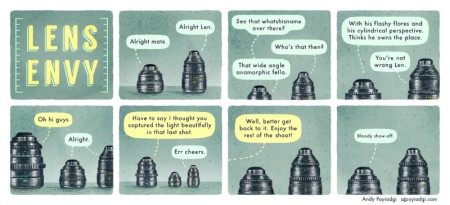 BF: Could you talk about your use of colour because throughout your strips it seems very considered; almost painfully so sometimes, with each panel seeming to have been individually and meticulously deliberated over. How important is the employment of colour in evoking mood and atmosphere to you?
BF: Could you talk about your use of colour because throughout your strips it seems very considered; almost painfully so sometimes, with each panel seeming to have been individually and meticulously deliberated over. How important is the employment of colour in evoking mood and atmosphere to you?
POYIADGI: My college tutor once told me I had a poor sense of colour so I think I’ve been trying to compensate for it ever since! Although it’s one of the most enjoyable parts of the process I always struggle with it at the start. If I have an idea of a palette, this usually goes out of the window and I’m forced to go with what looks right on the page. The other day I was determined to use blues and greens for a background but in the end I used purples and pinks. I was happy with the end result but it wasn’t what I expected. Once I’ve found a few colours that seem to work then I really begin to enjoy it. Then I can crack on and start listening to podcasts and audiobooks.
BF: And, finally, what can we look forward to seeing from Andy Poyiadgi in the future? What new comics ideas/projects do you have up your sleeves?
POYIADGI: I’m currently working on a couple of anthology contributions and a special teabag comic for the Lakes International Comic Art Festival in October. I’ll be exhibiting some of my work at the festival too, alongside Hannah Berry, Stephen Collins and Gareth Brookes, so I’m chuffed to be a part of that. I’ve also just submitted an idea for my first book, which all being well will be published sometime next year.
For more on the work of A J Poyiadgi check out his website here. You can buy his comics from his online store here.





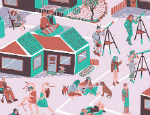
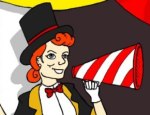
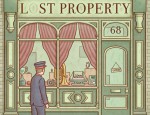

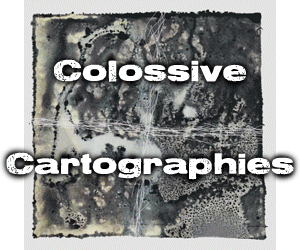





Thanks AO! It’s always a pleasure to bump into Mr Poyiadgi! If you haven’t seen his work before, I highly recommend that you do! Especially if you’re a tea lover!